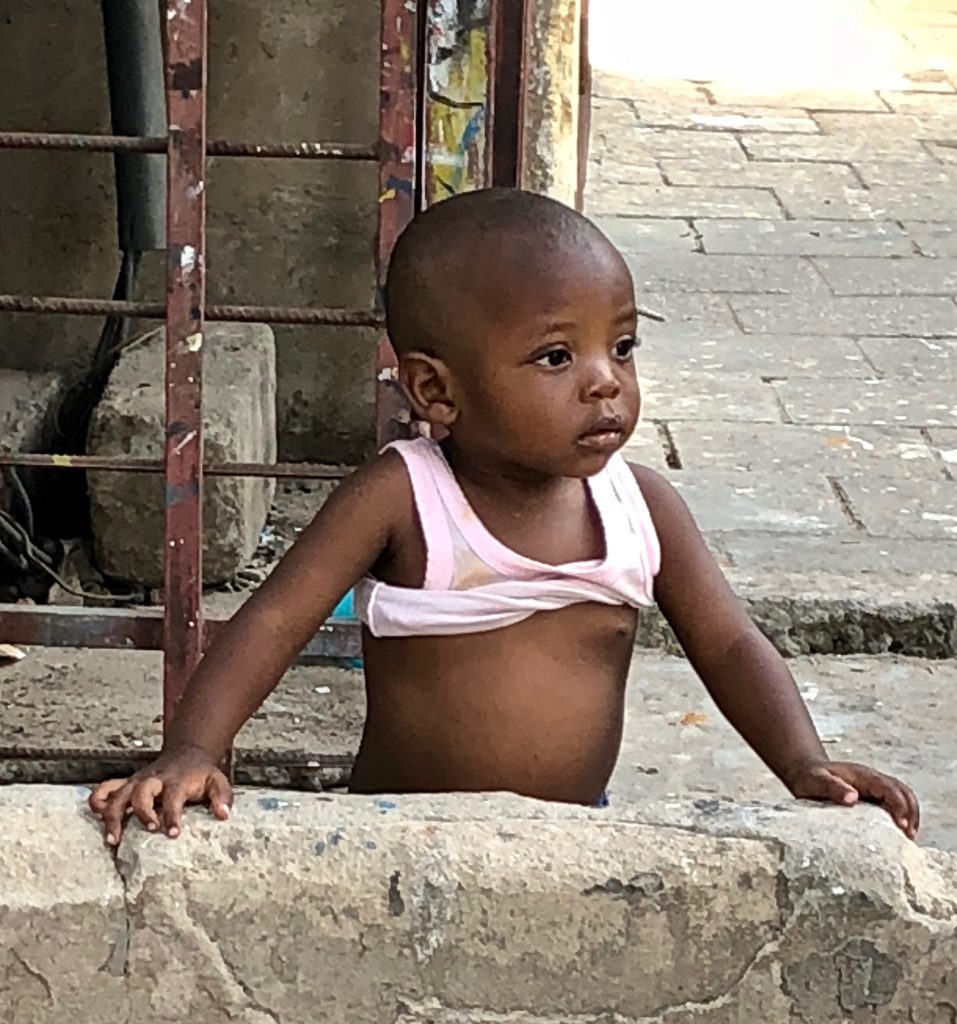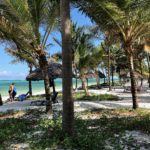Zanzibar 2018: Beaches and History
I came to Zanzibar because a friend from college 60 years ago, who was born in Tanzania and lives in Dar-es-Salaam, had built a villa on a bluff above the ocean on the island of Zanzibar and invited friends to visit. As I had not spent much time with him for many years, and was visiting Israel, already more than halfway to the island, I thought it was a good opportunity to take up the invitation. Besides, Zanzibar conjures an aura of exotic spices and ancient mixed cultures that attract world-travelers.
We entered the house through a heavy, carved Zanzibari door (see below), a baraza–a traditional bench where visitors are greeted with some libation and snacks to sit and chat—welcomed me. The entrance hall opened to a large sitting area with a family room to the left and a dining area to the right, partitioned by a carved wooden screen. The veranda outside flowed into a well-tended tropical garden, a swimming pool, and further, through a gate and down a ladder, to the ocean. Upstairs, skirting the bedrooms, another veranda allowed a better view. Looking at iridescent sunsets with a glass of wine was delightful. The timing of tides and the rocky beach did not make it easy to swim there, but once in, the water was warm and inviting.

Sunset View from the Villa’s Upper Verandah
Zanzibar is a small island 35 miles long and 12 miles wide, situated 25 miles off the coast of East Africa. It has a population of about 1.3 million with about half living in greater Zanzibar Town. The town sprawls over a wide area, but the commercial center known as Stone Town is compact. It reminded me of Dar-es-Salaam in the mid-1980s. Kenyatta Road, the main street, runs between simple rectangular buildings that house large shops on the ground floor and offices or apartments upstairs. Side streets wind away with smaller buildings and shops.
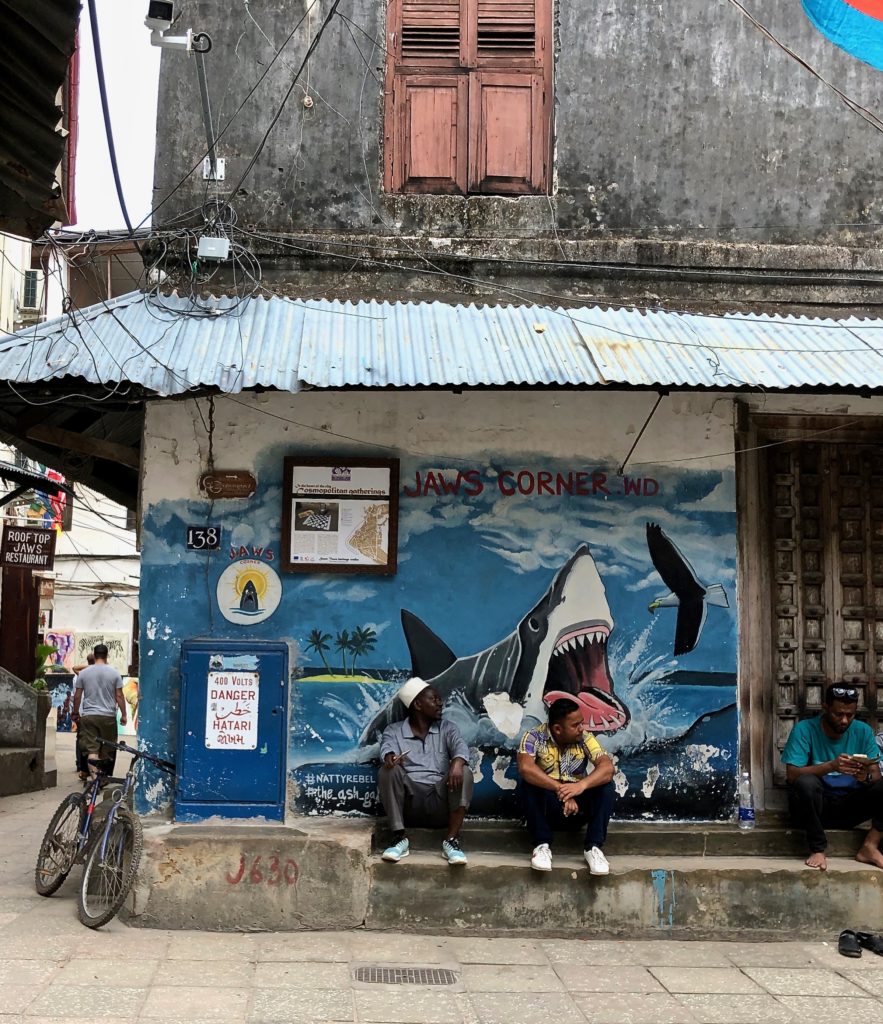
Stone Town Meeting Point
The traffic flows easily, except near the port, where progress was slow. In the better-off residential areas, houses are walled with barbed wire fences on top and guards check entry. Away from the center, it quickly devolves into townships that have cement block buildings with shops on the ground floor and rural areas with cultivated fields and tiny simple shops or roadside stalls. After several decades of development assistance, people don’t look noticeably better off since my last visit to the mainland in the mid-1980s.
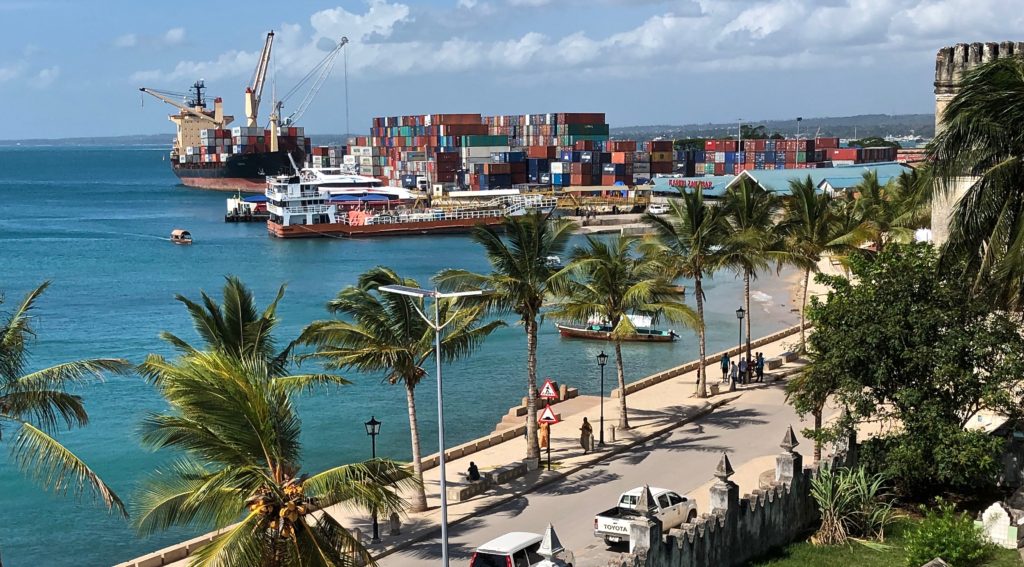
Port
Most of the population is Bantu, migrants from the mainland over millennia, with a sprinkling of South Asians and Arabs, a residue of many more who left in 1964, soon after the island gained independence from Britain, when several thousand were killed and dispossessed after a violent revolution. People speak Swahili, a mixture of Bantu languages, Arabic, Persian and loan words from Gujarati and English. English is understood fairly widely as well.
Zanzibar welcomes 300,000 visitors annually, which is a worry for local environmentalists. Most stay in the many hotels and resorts along the beaches and some stay in or visit Stone Town with its narrow, winding streets, austere Arabic architecture often with carved doors, shuttered windows and interior courtyards. It is a UNESCO world heritage site.
Traders from Arabia, Persia and India came to Zanzibar from the 1st Century CE. They would sail across the Indian Ocean during the monsoon bringing iron, cloth, sugar and dates and exchange them for ivory, cloves, tortoiseshell and slaves, and leave when the winds changed direction. Around the 11th Century, small numbers of traders began to settle on the island, intermarrying with the indigenous people.
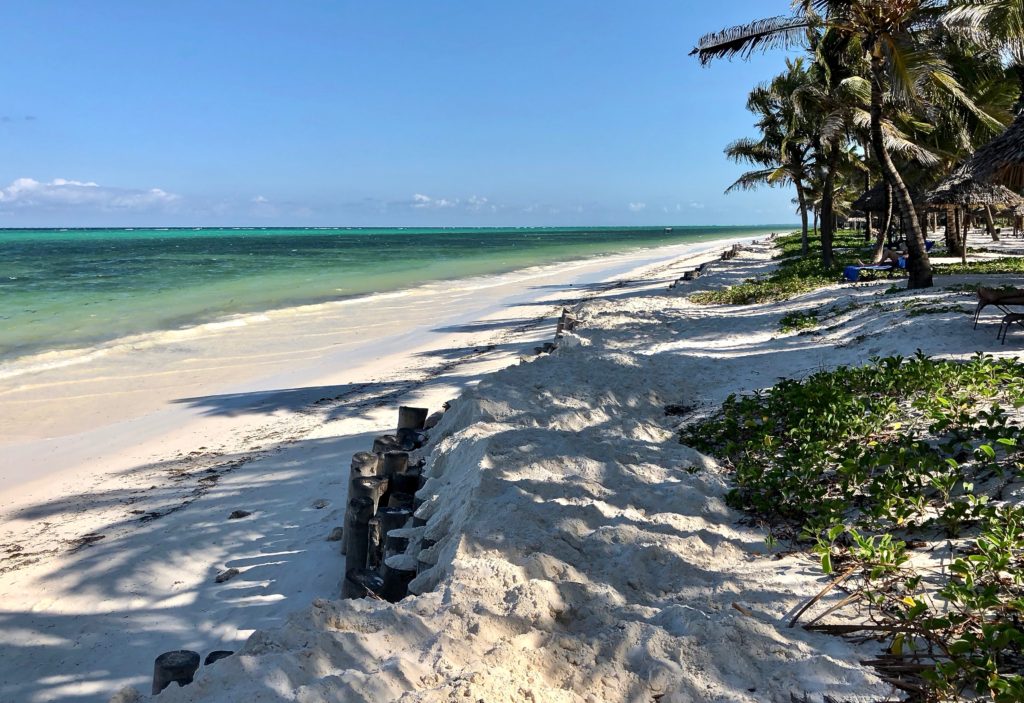
Baraza Beach
As trade grew, Zanzibar came to be ruled by the Portuguese during the 16th and 17th Centuries; Arabs from Oman during the 18th and 19th Centuries; and British from the 19th and 20th Century until 1963, when the island gained independence. A year later, Zanzibar joined with Tanganyika to form Tanzania, but retained its semi-autonomous status with its own assembly. Its President serves as the Vice-President of Tanzania.
Despite the departure of the Arabs, Indians and British after the Revolution, their influences remain in religion and architecture. Virtually the entire population follows Sunni Islam, and small numbers follow branches of Christianity and Hinduism as well. Structures such as mosques, churches, temples, palaces and forts show that Arabs, Europeans and Indians have lived on the island. These buildings, mostly in the Stone Town, are the main attractions for tourists. It is a warren of snaking alleys that are difficult to navigate even with a map as most have no names posted. Shop-houses on both sides sell tourist kitsch, including Tingatinga art, a distinct form of simplified and/or fantastical depiction of animals and birds in bold colors. As every shop displayed these paintings, I wondered if there was a factory nearby mass-producing them. After a considerable search, I found a tiny gallery that had a few abstract paintings among the tourist delights. One piece stood out, which I bought as a souvenir of my visit. At times, there were more hawkers than tourists, which got to be annoying, but they were polite and backed-off at a not-interested hand signal.

Stone Town Market
A bustling market on the edge of Stone Town attracts locals and tourists. It has spaces for meat and fish and a long hall with stalls selling everything, noticeably colorful, patterned Kanga cloth and aromatic spices. At the other end of town are the remnants of the Old Fort built in 1700 by Omani Arabs on the site of a Portuguese chapel. It has a large courtyard, a part of which is now used as an amphitheater that is surrounded by shops and cafes. The exit toward the ocean leads to the well-tended Forodhani Gardens with tropical plants, seaside cafes and food court stalls in the evening. Next to the fort is the huge House of Wonders, so named because it was the first building to have electric light installed. It was built as a ceremonial palace in 1883 by Sultan Barghash and is now a museum, but it was closed for renovation. Adjacent to it is the Palace Museum built as the Sultan’s palace. It is a white building with streaks of grey from rain, and musty inside, perhaps because the display is mainly furniture that is up to 150 years old. The balcony off the top floor gives a great view of the ocean and the busy port area nearby. Along the sea front, just as the port begins is the Old Dispensary, which stands out as a remarkable four story building with decorative balconies designed by an Indian architect and begun in 1887 for Tharia Topan, a rich Ismaili Indian merchant, to celebrate Queen Victoria’s Jubilee. When the money ran out it became a dispensary under the next owner.
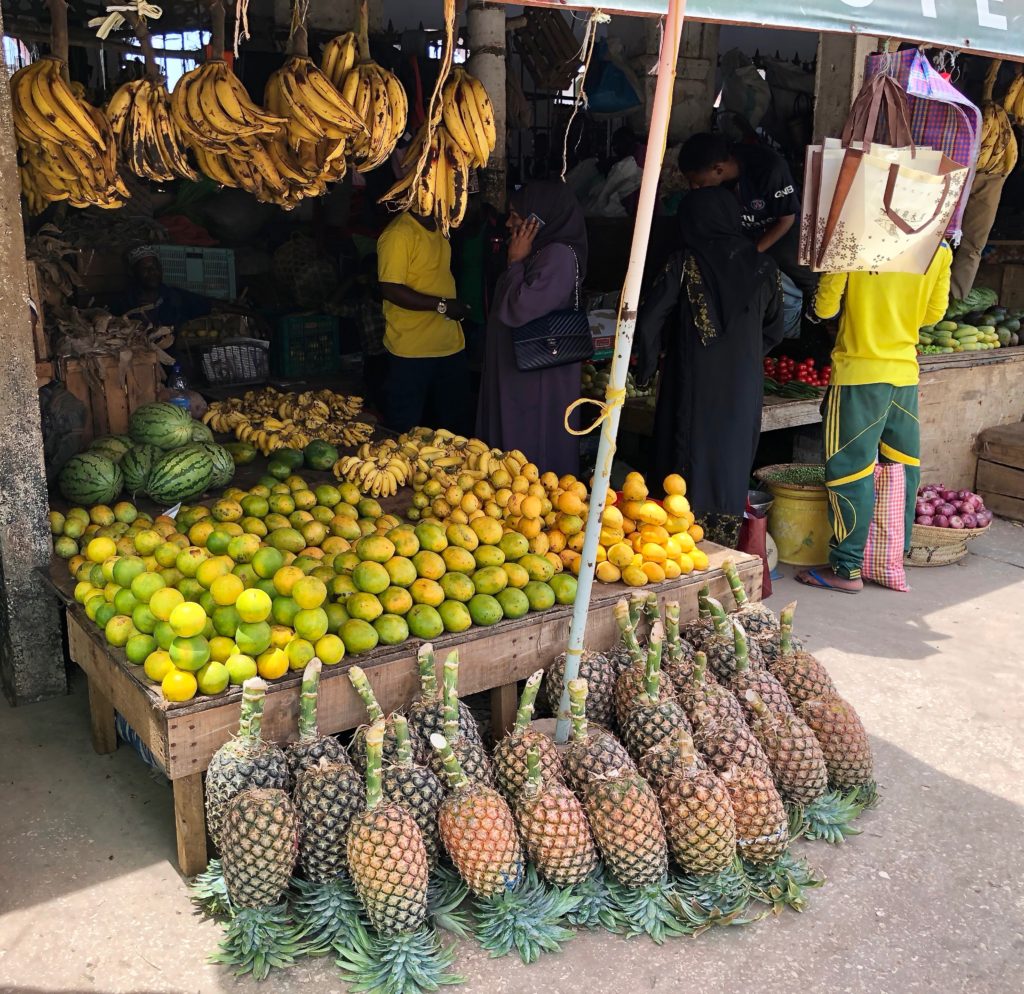
Stone Town Market
The exhibits formerly on display at the House of Wonders were transferred to the Zanzibar Museum of Art at the southern end of Stone Town. It looks like a religious building, a whitish central large dome surrounded by smaller ones and its windows are shaped like those in a mosque or church. It was opened in 1925 to commemorate the end of the First World War. The exhibits are folk crafts and art including some eye-catching colorful Kanga textiles. It has one of David Livingstone’s medicine chests and small displays of Zanzibari doors, distinctly carved entrances to houses, symbolizing occupation such as waves for a merchant, frankincense and date palms for wealth. Doors to more wealthy Indian homes have semi-circular arches or rectangular carved doors studded with decorative brass spikes. Arab doors are rectangular with carved frames and lintels sometimes with quotations from the Koran. The museum’s entrance door is apparently the oldest, dating from about 1700 CE.
Among religious buildings, Sunni and Shia mosques dominate in number, but are not architecturally as impressive as in many other countries. St. Joseph’s Cathedral, built at the end of the 19th Century by French missionaries to cater for the small Roman Catholic community, is impressive with stained glass windows and murals. The Anglican Cathedral completed in 1880 on the East side of Stone Town was built on the site of the old slave market. A window is dedicated to the memory of David Livingstone and the church’s crucifix is made from wood from the tree under which his heart was buried on the mainland. He famously called Zanzibar “Stinkibar” because of the stench from the refuse piled up at the seashore. Stone Town and the seashore are now cleaner, but refuse piles are visible now and again where the alleys converge to a square or where a building has collapsed. Other famous explorers of Africa such as Stanley, Burton and Speke spent time in Zanzibar as well. Next to the Anglican cathedral is a Slave Trade Exhibit covering the period 1880-1909 that graphically details the inhumane treatment of these mainland people who were sold mainly to Arab countries. At its height in 1860, about 20,000 slaves were traded. British dominance in the region finally put an end to that horrible chapter in Zanzibar’s history. Partially sunken statues of five chained slaves depicting their plight was built by a Scandinavian artist in the cathedral grounds.

Slave Trade Exhibit
Zanzibar recognizes Freddie Mercury, or Farouk Bulsara, the lead singer of the rock band “Queen” with a plaque on a house on Kenyatta Road where the family lived and a restaurant-bar is named after him as well. His family came from India and his father worked as an accountant for the British government in the House of Wonders, which was used at the time by the British as government offices. Freddie went to boarding school in India and college in London, and later formed Queen with a couple of his college-mates. The family fled to the UK after the 1964 Revolution. Although Freddie is considered a great rock singer, I had not heard any of his recordings. By coincidence a newly released movie about him and his band, “Bohemian Rhapsody”, was showing in Marin when I got back. It was awarded the Golden Globe for the best movie of 2018 and its soundtrack was indeed impressive.
The island is chock-full of beach resorts. My friend and I were invited to spend an afternoon at Baraza, a luxurious resort on the east coast of the island. It has villas built in Omani architecture, separated by gardens, pools, restaurants, spas and an endless, sparsely used white-sand beach ocean-side. The water was warm, but it was a breezy day, stirring the waves that made my swim uncomfortable. A long walk along the deserted beach was delightful. On another day, I walked along Kizingo beach close to Stone Town, more of a fisherman’s area. It was another breezy day, too rough for the simple fishing boats to go out. They were moored and fishermen were busy repairing them and their nets. About halfway going east from Zanzibar Town to Baraza Resort, I visited Josani National Park. A guide walked a group of us through a forest of several species of palm and mahogany trees and showed us a family of red Colobus monkeys, the main attraction of the park. On the other side of the road, is a forest of mangrove trees with a boardwalk through it for tourists to go deep into the swamp and view the ecology.
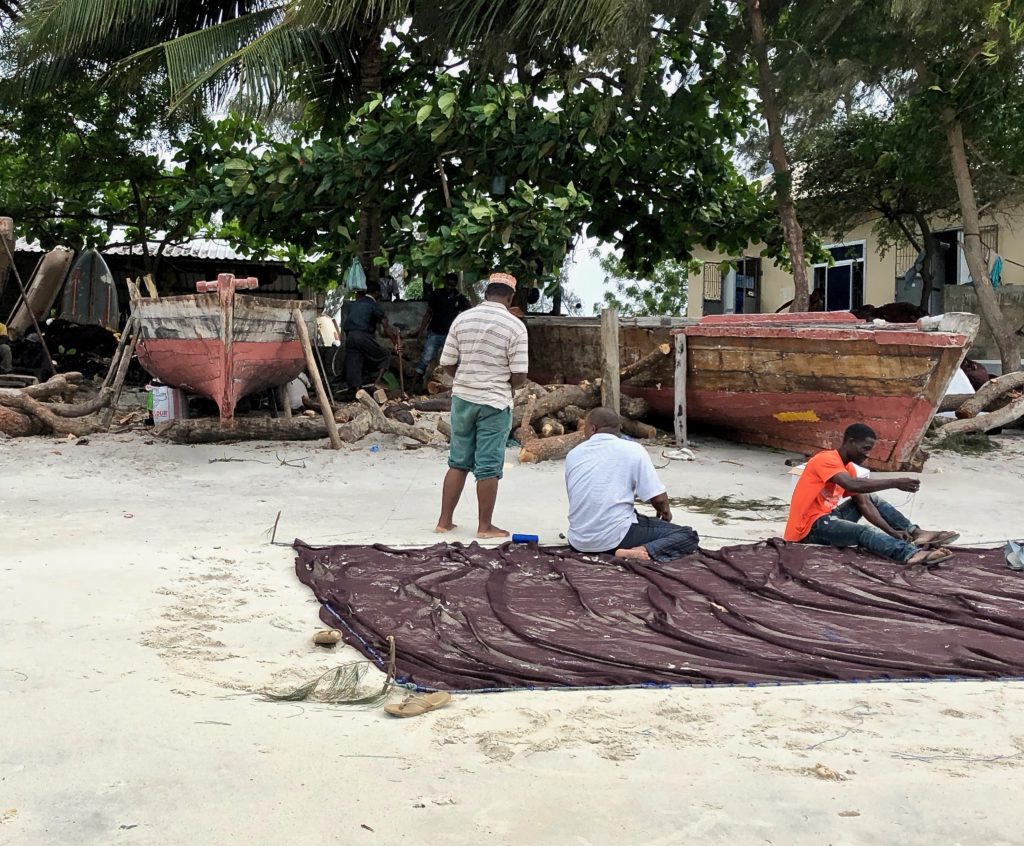
Kizingo Beach
I ate too well in Zanzibar. My friend’s cook made delicious Ismaili Indian food. Her shrimp in coconut, aromatic fish, and potato and eggplant curries were my favorites. There was no need to eat out, but to experience local food, I tried a few restaurants with my friend. The best experiences were at two restaurants in Emerson Spice, a boutique hotel in a renovated merchant’s house. We climbed endless wooden steps to get to the Rooftop Teahouse Restaurant that sported a spectacular view of Zanzibar Town at sunset. Our prix fixe five course seafood menu had unusual preparations of locally sourced seafood and produce. Dishes with names like Prawns, Green Papaya Salad, Pineapple Chutney, Garlic Nyanya Chungu; Mama Sita’s Tuna Watermelon Salad, Mbirimbi Achari; and Passion and Mango Givre, Date Cream, Cardamom Mango give you some idea. The accompanying light, white South African wine helped open the diverse flavors and the Michelin Star level of service added to the experience. The hotel’s other restaurant Secret Garden in a patio on one side of it, offered simpler dishes such as Zanzibar Squid Ink Risotto with Calamari and local Lemon, but well-prepared and bursting with flavor. Other restaurants that offered Spanish tapas, Italian fare and the buffet at the Baraza resort were not memorable.
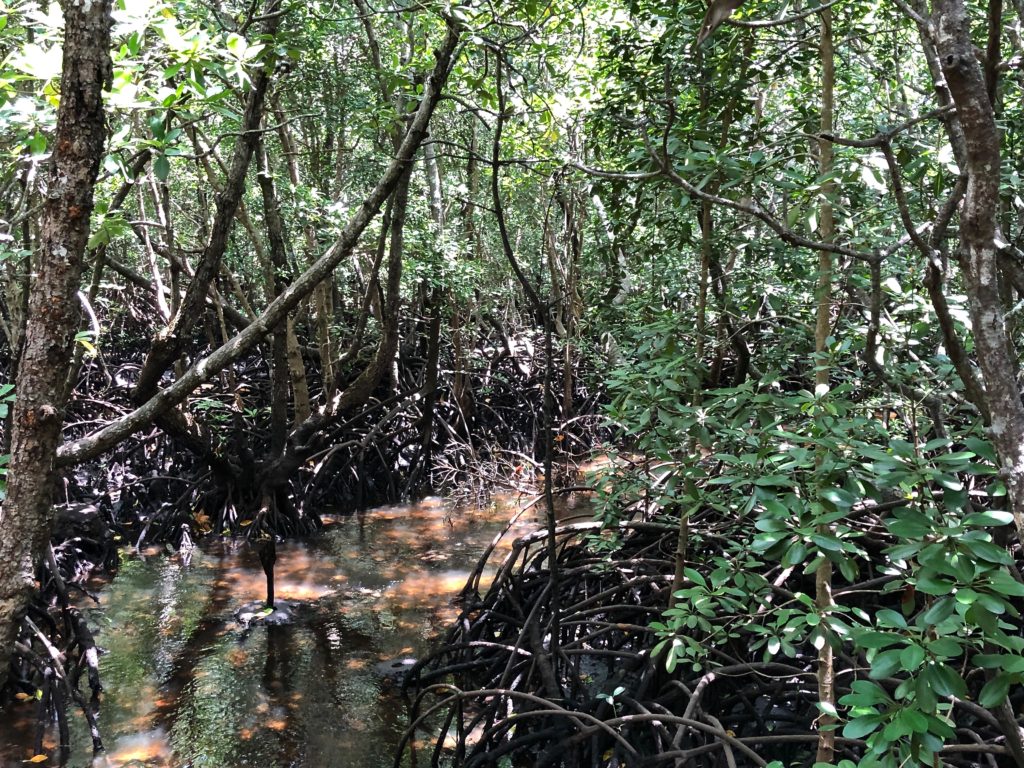
Mangrove Forest, Josani National Park
Coming into and leaving Zanzibar were experiences I could have done without. I walked briskly off the flight from Tel Aviv into the small Zanzibar airport expecting to breeze through immigration and customs as I had downloaded and completed the visa form. Boy, was I mistaken. I joined the immigration line, but after a while found out that I should have first joined the visa payment line, which was now a hundred deep. As it crept forward, I saw people trying to get immigration forms to fill in. I felt smug for having completed mine, but I was wrong again. This was an additional form that asked for the exact same information. It took an hour to pay $100 for the visa and then I joined the immigration line for at least another hour. Would you know it, just as I got to the front, the visa-printing machine malfunctioned, which took a half hour to fix. By the time I eventually got out and found my ride, the driver said he was about to give up on me, thinking I was not on the flight.
Getting out of Zanzibar turned out even more difficult than coming in. Negligently, four or five international flights were scheduled to depart in close proximity in the evening from the tiny airport. The line to get through the initial security screening took over an hour, but of course there was another Zanzibari security station before reaching the airline desks. As I was flying on an Israeli carrier, their much vaunted security screening was my worst experience. As my passport shows that I was born in Pakistan, I was profiled as a Muslim and questioned and searched for one hour. As if the profiling was not bad enough, they knew nothing about India’s partition or the World Bank where I had worked for a number of years. As my passport showed visits to several Middle East and Muslim African and Asian countries, I was taken to be a potential terrorist until I proved I was not. It was an unpleasant experience that put me off using an Israeli airline again. All departures were delayed, mine for 3.5 hours. A few hundred passengers had to wait in a small hot and humid lounge. Just before boarding, it began to rain, which many passengers ignored, glad to get out of the lounge and run to the plane.
With my decades of experience working on developing countries, I should expect this shambles, but I thought the process in a small island that depended on tourism for a quarter of its income would be at about the same level as many other developing countries that have streamlined their immigration at airports, including India, the champion of needless and painfully slow bureaucratic procedures.
